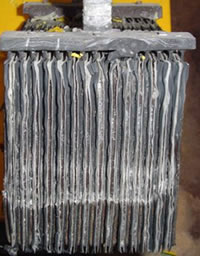Technical info - Low temperature operation
Freezing
If a battery would be discharged in a cool room with a constant temperature of 0°C, the battery would give only around 80% of its rated capacity and would be completely discharged when the specific gravity dropped to 1.140. Electrolyte of this S.G. would freeze at around -15°C, giving a margin of 15°C between the electrolyte temperature and its freezing point.
Similarly, at an electrolyte temperature of -20°C a battery would give only 50% of its rated capacity and have a fully discharged S.G. of about 1.180. At this level of S.G. freezing occurs at around -26°C; the margin between the electrolyte and its freezing point is 6°C.
This acts as an inbuilt protection against electrolyte freezing because the capacity that can be taken from a battery is reduced at low temperatures and the fall in S.G. is consequently less. This means that for any given electrolyte temperature the capacity which the battery delivers is not sufficient to freeze. It follows that the only time the electrolyte would freeze is when the battery is fully discharged and then left in a cold room for a lengthy period of time.

